IN
CHATINO COUNTRY
By
Barbara Schaffer
What's on the other side of the highway? we've often wondered, as
we've driven along the coast to the Laguna de Manialtepec. So one
fine day we left Puerto heading west and took the dirt road to San
Antonio Cuitxtla. The sign on the highway said it was 8 km away, but
we had been forewarned that the road up the mountain was steep and
slow. In fact it took us almost a half an hour to ascend to the village.
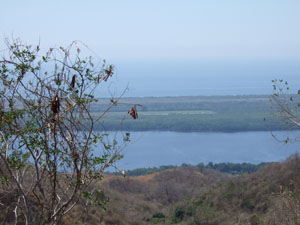
It being dry season, the land was parched. It reminded us of the deserts
of Sonora and Baja California. But here and there, in a valley, we'd
see a cornfield, and we crossed a small stream. The real payoff, however,
was the spectacular view of Manialtepec, which at this time of year
is a lake cut off from the sea.
The village of Cuixtla is on top of the mountain, and is made up mostly
of reed houses with palm leaf roofs, although there were some houses
of brick. Every thing sparkled in the sun and looked well maintained.
The two short streets that run though the town, connecting one dirt
road to another, were paved and there were several shops. There was
a school, a public health dispensary, and an evangelical church. We
saw children riding new bicycles. It seemed like a nice place.
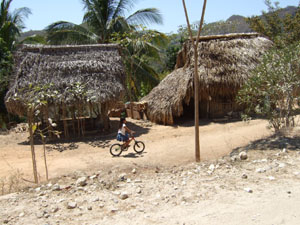
We wanted to continue further into the mountains, hoping to reach
Nopala through the back roads. But we were told that the road was
not passable by car. So we headed back down the mountain the way we
had come.
At this point it must be mentioned that our fascination with the mountains
above Puerto is not merely about going to places off the Google Earth
grid; we also wanted to know the land of the Chatino people. Many
people who live and work in Puerto are Chatinos. Although few speak
the language of their grandparents, they are very proud of their ancestry
and their long history in the region.
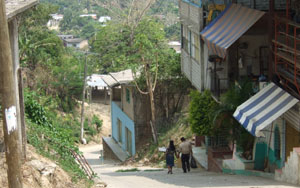
The most important Chatino settlement is the city of Santos Reyes
Nopala. Nopala was settled by the Chatinos around 800 A.D. But some
historians believe the Chatino people have been in the region since
2,300 B.C. Today Nopala has over 15,000 inhabitants, half of whom
speak Chatino.
Nopala is a beautiful, hilly city easily accessible from Puerto on
well-paved highways. You just head out of town on the Avenida Oaxaca
until you arrive in San Gabriel - around an hour from town on Rte.
131. From there you take the turn off for Nopala and continue for
another half hour.

A highlight of your visit should be the city hall where stelae (carved
stone slabs) from the 6th to 8th century are embedded in the walls.
The stelae were found 5 km from the city and in 1966 were brought
from their original sites by ox teams over steep mountain passes.
This enormous project was carried out in order to protect the stelae
and to connect with the classic period of Chatino culture.
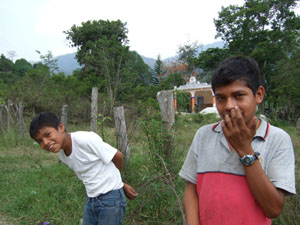
Nopala played a key role in the Chatino Rebellion of 1896. Until the
arrival of the coffee plantations in the mid 19th century, the Chatinos
had been spared most contact and interest by the outside world. Although
coffee was a boon for plantation owners and for the state economy;
it meant losing farmland for the natives of the region, and, on top
of that, having to pay taxes to the state.
On April 6, 1896, the Chatinos attacked the district capital of Juquila.
Their battle cry was "Death to all who wear pants," by which
they meant whites and mestizos dressed in European clothes, as opposed
to the traditional "calzones". They burned the town hall
and its archives, and they beheaded 22 of the town people with machetes,
including important government officials and agents of the coffee
plantations.
It took two weeks for government troops to recapture the city. Thirty
of the rebels were executed; others were exiled to Quintana Roo. The
rebellion is now known to history as the War of the Pants.
Further afield, the small Chatino town of Yaitepec is a quiet gem
in the mountains not far from Santa Caterina Juquila. There most of
the 3,000 inhabitants speak Chatino and wear their traditional clothes.
Interestingly,
however, the image of the child Jesus with the Virgin Mary, on the
church's stained glass window, shows Jesus in pants while the Virgin
is in medieval garb.
Sol de la Costa March 2009
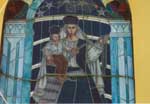
Yaitepec






